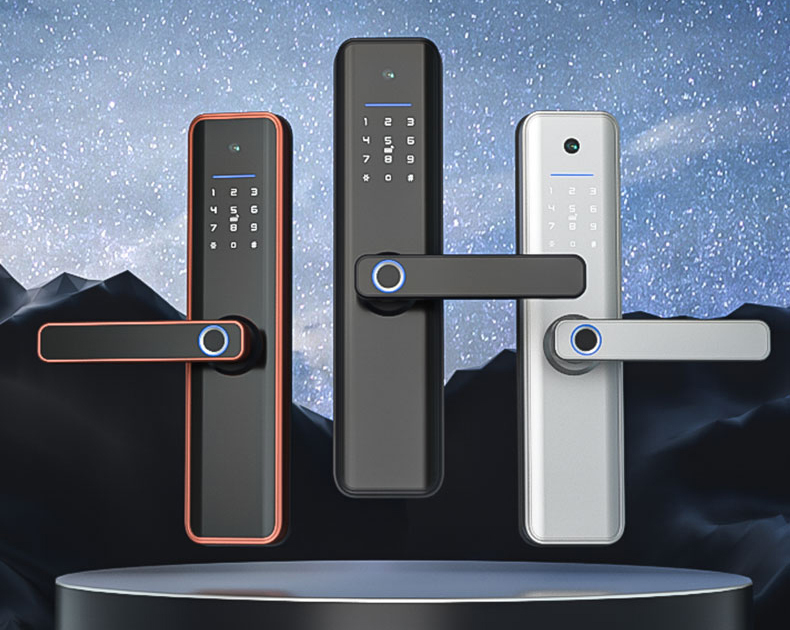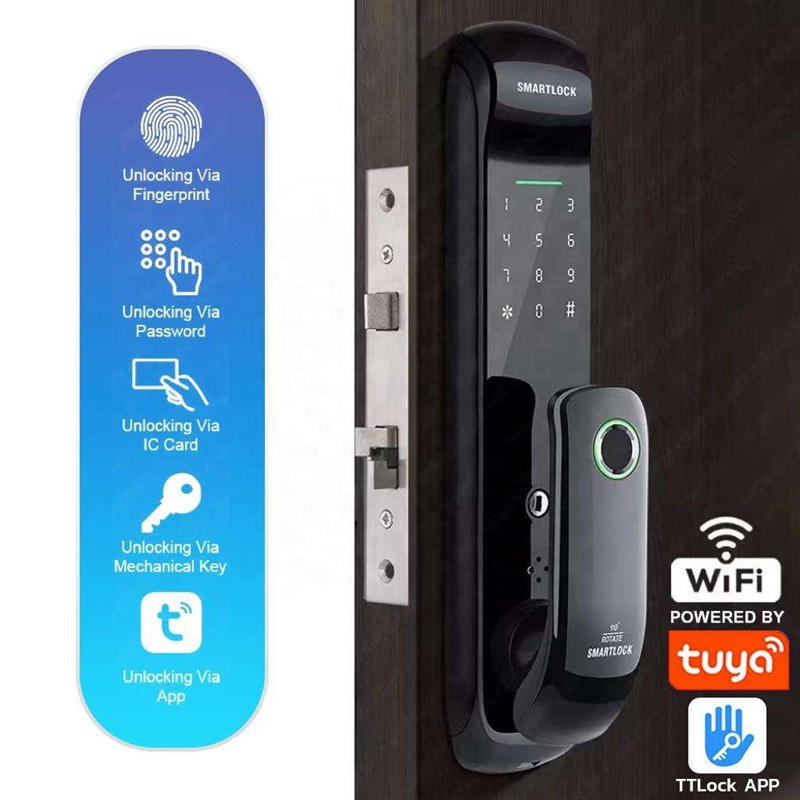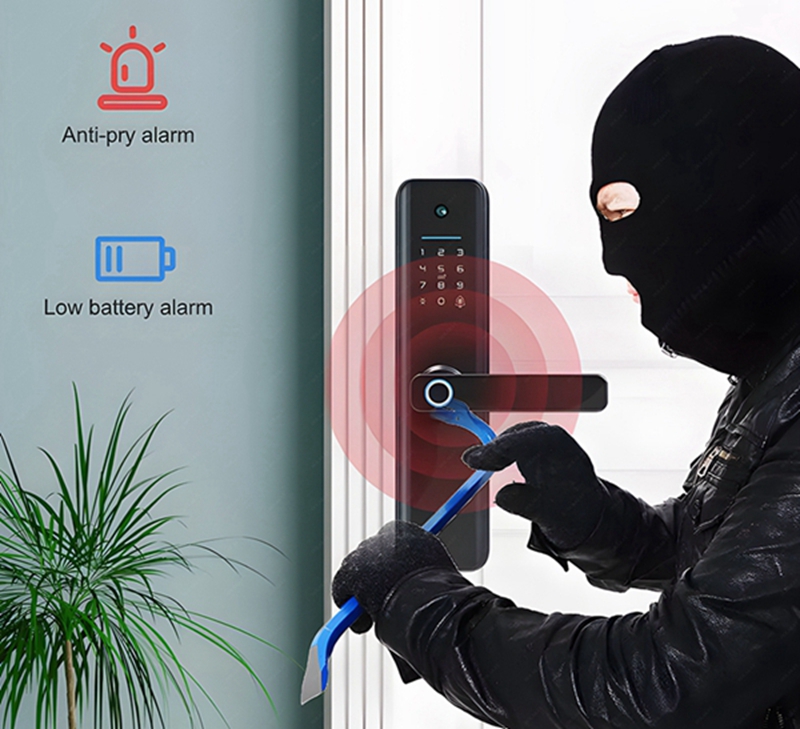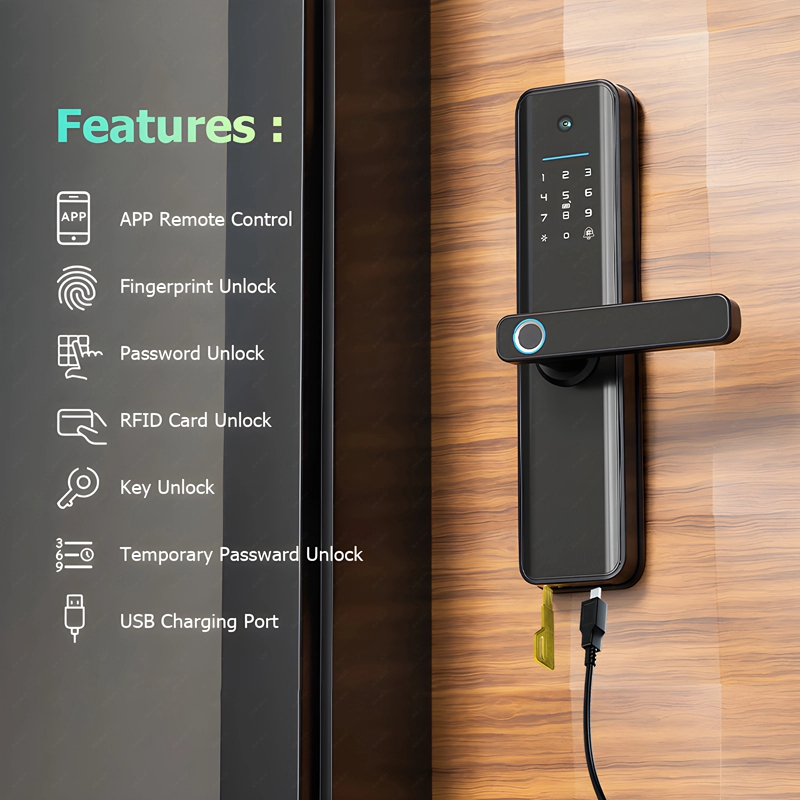1. What are the different types of mainstream smart locks, and how do they differ from each other?
Answer: Smart door locks can be divided into two types based on the transmission method: semi-automatic smart locks and fully automatic smart locks. They can generally be distinguished by the following criteria:
External appearance: Semi-automatic locks usually have a handle, while fully automatic locks typically do not.
Operating logic: After authentication, semi-automatic smart locks require pressing down the handle to open the door and lifting the handle to lock it when going out. Fully automatic smart locks, on the other hand, allow direct door opening after authentication and automatically lock when the door is closed without any additional action.
It’s important to note that some fully automatic smart locks use a push-pull lock body with self-locking feature. After authentication, these locks require pushing the front panel handle to open the door and automatically lock when closed.
2. How do I choose from the various biometric authentication methods used in smart locks? Can fake fingerprints unlock the lock?
Answer: Currently, there are three mainstream biometric unlocking methods for smart locks: fingerprint, face recognition, and vein recognition.
❶ Fingerprint Recognition
Fingerprint recognition stands as the prevailing biometric unlocking method extensively employed within the smart lock market. It has been extensively researched and applied in China, making it a mature and reliable technology. Fingerprint recognition offers high security, stability, and accuracy.
In the smart lock industry, semiconductor fingerprint sensors are commonly used for fingerprint unlocking. Compared to optical recognition, semiconductor sensors provide improved sensitivity and accuracy. Therefore, the claims about unlocking with fake fingerprints found online are generally ineffective for smart locks equipped with semiconductor fingerprint sensors.
If you have no specific requirements for unlocking methods and prefer a mature recognition technology, it is recommended to choose a smart lock with fingerprint recognition as the main feature.
❷ Face Recognition
Face recognition smart locks scan the user’s facial features using sensors and compare them with the pre-recorded facial data in the lock to complete the identity verification process.
Currently, most facial recognition smart locks in the industry adopt 3D facial recognition technology, which offers higher security and accuracy compared to 2D facial recognition.
The three main types of 3D facial recognition technology are structured light, binocular, and time-of-flight (TOF), each using different data collection methods to capture face information.
3D face recognition allows unlocking without direct contact with the lock. As long as the user is within the detection range, the lock will automatically recognize and open the door. This futuristic unlocking method is suitable for users who enjoy exploring new technologies.
❸ Vein Recognition
Vein recognition relies on the unique structure of veins in the body for identity verification. Compared to explicit biometric information like fingerprints and facial features, vein recognition provides higher security as the vein information is hidden deep inside the body and cannot be easily replicated or stolen.
Vein recognition is also suitable for users with less visible or worn-out fingerprints. If you have older adults, children, or users with less prominent fingerprints at home, vein recognition smart locks are a good choice.
3. How can I determine if my door is compatible with a smart lock?
Answer: There are various specifications for door lock bodies, and smart lock manufacturers generally consider most of the common specifications on the market. In general, smart locks can be installed without changing the door, unless it is a rare specialized lock or a lock from a foreign market. However, even in such cases, installation can still be achieved by modifying the door.
If you want to install a smart lock, you can communicate with the seller or professional installers. They will help you find a solution. Smart locks can be installed on wooden doors, iron doors, copper doors, composite doors, and even glass doors commonly used in offices.
4. Can smart locks be used by older adults and children?
Answer: Absolutely. As our society enters an aging population era, the proportion of older adults is increasing. Older adults often have poor memory and limited mobility, and smart locks can perfectly meet their needs.
With a smart lock installed, older adults no longer have to worry about forgetting their keys or rely on others to open the door. They can even avoid situations where they climb through windows to enter their homes. Smart locks with multiple unlocking methods are suitable for households with older adults, children, and other users with less prominent fingerprints. They offer convenience for the entire family.
When older adults are unable to open the door, whether they are outside or inside the house, their children can remotely unlock the door for them through a mobile app. Smart locks equipped with door-opening record monitoring functions allow children to monitor the door lock’s status at any time and detect any unusual activities.
5. What should I consider when purchasing a smart lock?
Answer: When selecting a smart door lock, consumers are advised to consider the following points:
❶ Choose a smart lock that suits your needs instead of pursuing unique features or unlocking methods blindly.
❷ Pay attention to the product’s safety and ensure it is made of high-quality materials.
❸ Purchase smart door lock products from legitimate channels and carefully inspect the packaging to ensure it includes a certificate of authenticity, user manual, warranty card, etc.
❹ Confirm whether your door has a latchbolt, as it is advisable to remove the latchbolt when installing a fully automatic smart lock to prevent excessive power consumption. If you are unsure about the presence of a latchbolt, communicate with the store or online customer service promptly.
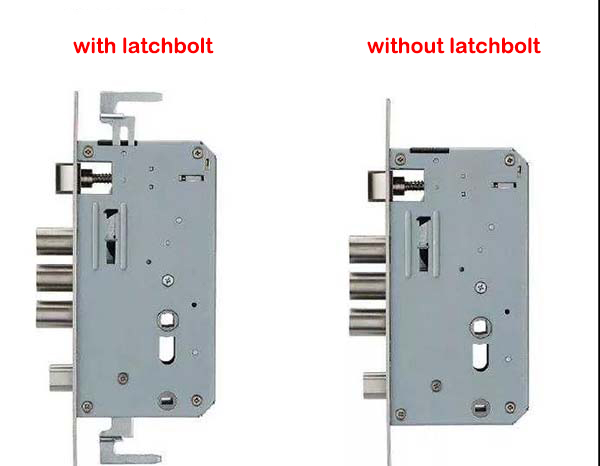
❺ Consider whether you are concerned about unlocking noise. If you don’t mind the noise factor, you can choose a rear-mounted clutch fully automatic lock. However, if you are sensitive to noise, it is recommended to consider a fully automatic lock with an internal motor, as it produces relatively less noise.
6. How should smart lock installation and after-sales service be arranged?
Answer: Currently, smart lock installation requires a certain level of expertise, so it is essential for sellers to provide after-sales services and address any installation or setup-related queries from customers.
7. Should we keep the escutcheon plate when installing a smart door lock?
Answer: It is recommended to remove it. The escutcheon plate enhances the protection between the door and the frame by creating a sturdy lock on the opening side. However, it has no relation to the security of the smart door lock. Once the main lock is opened, the escutcheon plate can be easily opened as well.
Moreover, installing the escutcheon plate with the door lock has certain drawbacks. On one hand, it adds complexity and more components, which not only inconveniences the installation process but also increases the risk of lock malfunctions. On the other hand, the additional bolt increases the force applied to the lock, resulting in a heavy burden on the entire lock system. Over time, this can weaken its durability, leading to frequent replacements that not only incur high costs but also unnecessary troubles in daily life.
Compared to the theft prevention capabilities of the escutcheon plate, mainstream smart locks now offer theft alarms and handling mechanisms that are comparable.
Firstly, the majority of smart locks come with anti-destruction alarm functions. In case of violent tampering by unauthorized individuals, the lock can send warning messages to the user. Smart locks equipped with video features can also monitor the surroundings of the door, along with motion detection capabilities. This allows continuous surveillance of suspicious individuals outside the door, capturing images and videos to be sent to the user. Thus, potential criminals can be detected even before they take action.
8. Why are smart locks designed with keyholes similar to traditional mechanical locks, despite their advanced features?
Answer: At present, the smart lock market offers three recognized methods for emergency unlocking: mechanical key unlocking, dual-circuit drive, and password dial unlocking. The majority of smart locks use a spare key as an emergency solution.
Generally, the mechanical keyhole of smart locks is designed to be discreet. This is implemented for both aesthetic purposes and as a contingency measure, thus it is frequently concealed. The emergency mechanical key plays a crucial role when the smart lock malfunctions, runs out of power, or in other special circumstances.
9. How should smart door locks be maintained?
Answer: During the use of smart locks, it is important to pay attention to product maintenance and follow several precautions:
❶When the battery of the smart door lock is low, it should be replaced in a timely manner.
❷If the fingerprint collector becomes damp or dirty, gently wipe it with a dry, soft cloth, taking care to avoid scratches that may affect fingerprint recognition. Avoid utilizing substances like alcohol, gasoline, or solvents for the purpose of cleaning or maintaining the lock.
❸If the mechanical key is not operating smoothly, apply a small amount of graphite or pencil powder to the keyhole slot to ensure proper key operation.
❹Avoid contact between the lock surface and corrosive substances. Also, do not use hard objects to strike or impact the lock casing, to prevent damage to the surface coating or indirectly affect the internal electronic components of the fingerprint lock.
❺Regular inspections are recommended since door locks are used daily. It is advisable to check every six months or once a year, inspecting for battery leakage, loose fasteners, and ensuring proper tightness of the lock body and striker plate gap, among other aspects.
❻Smart locks typically contain intricate and complex electronic components. Disassembling them without professional knowledge may damage internal parts or lead to other serious consequences. If there are suspicions of problems with the fingerprint lock, it is best to consult professional after-sales personnel.
❼If the fully automatic lock uses a lithium battery, avoid charging it directly with a power bank, as this can accelerate battery aging and even lead to explosions.
10. What should I do if the smart lock runs out of power?
Answer: Currently, smart locks are mainly powered by dry batteries and lithium batteries. Smart locks are equipped with a built-in low battery alarm function. When the battery is running low during regular use, an alarm sound will be emitted. In such cases, please replace the battery as soon as possible. If it is a lithium battery, remove it and recharge it.
If you have been away for a long time and missed the battery replacement time, in case of an emergency door opening, you can use a power bank to charge the door lock. Then, follow the above-mentioned method to replace the battery or charge it.
Note: In general, lithium batteries should not be mixed. Please use the matching lithium batteries provided by the manufacturer or consult professionals before making a decision.
Post time: May-25-2023

